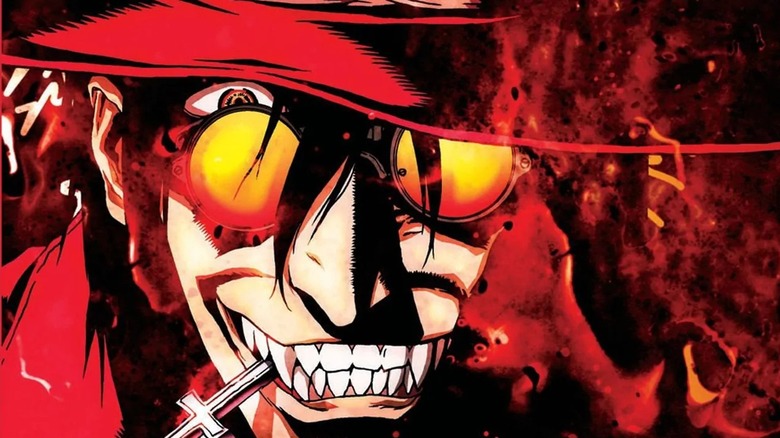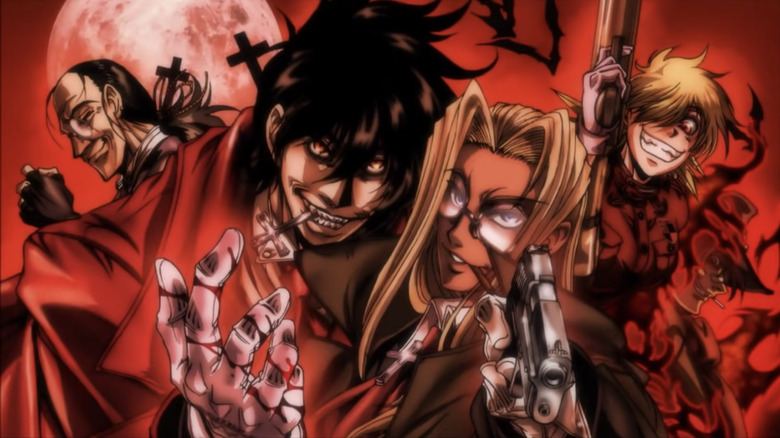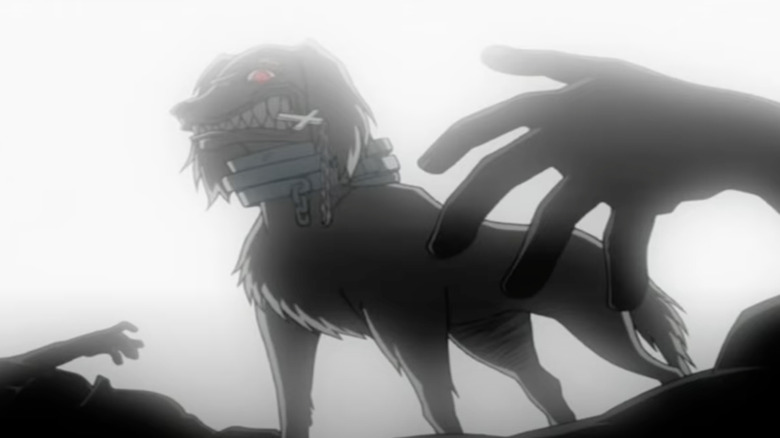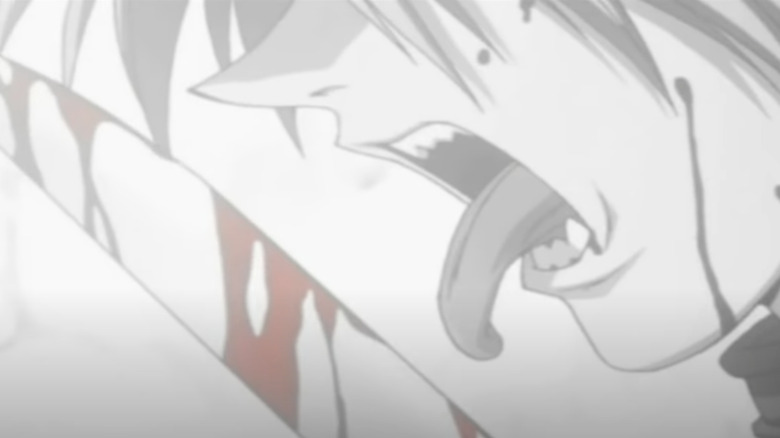The One Advantage The First Hellsing Anime Has Over Ultimate
Kouta Hirano's action-horror manga "Hellsing" begins 100 years or so after Abraham Van Helsing defeated Dracula. Contrary to the account of Bram Stoker, the Lord of Vampires was not slain, merely cowed, and became the Helsing (eventually Hellsing) family retainer. Abraham's descendant, Sir Integra Fairbrook Wingates Hellsing, leads an eponymous ghoul-hunting organization. Her top agents are the rechristened Alucard and his newly sired protégé, Seras "Police Girl" Victoria.
Hellsing's enemies are two-fold. First, there's Iscariot, the Vatican's vampire slayers who rival the Protestant Hellsing; Father Alexander Anderson is particularly dead-set on killing Alucard. Second, there's Millennium, a Nazi remnant who experimented with the occult and still intends to bring about a thousand-year Third Reich. If you're not much of a manga reader, don't fear, for "Hellsing" has been adapted into an animated series. However, if you're looking to watch the "Hellsing" anime, you'll have to decide: Which one? That's right, there are two adaptations. The first series is simply titled "Hellsing," while the more faithful adaptation was correctly named "Hellsing: Ultimate."
The two versions are not connected beyond the common source material and some overlapping English dub actors, as they were created by different studios boasting different stories and styles. In my humble opinion, the reinterpretation of the manga was warranted, and "Ultimate" is definitely the superior of the two series. That said, if you watch anything from the first "Hellsing" anime, make sure it's Yasushi Ishii's incredible opening theme: "Lagos Naki World" aka "A World Without Logos."
Hellsing Gonzo or Hellsing Ultimate?
First, let's talk about the different versions of "Hellsing." Kouta Hirano's original "Hellsing" manga was published in the seinen magazine "Young King OURs," running for 11 years between 1997 and 2008. In the fourth year of its run, animation studio Gonzo produced the 13-episode "Hellsing" anime. Despite some impressive talent, including scriptwriter Chiaki J. Konaka (of "Serial Experiments Lain" and "Digimon Tamers"), Gonzo's "Hellsing" is pretty mediocre. The animation is stiff and betrays a low budget. While running out of source material doesn't necessarily doom an anime (see 2003's "Fullmetal Alchemist"), it unfortunately did for "Hellsing."
Gonzo's "Hellsing" broke away from the manga after episode 7 (roughly chapter 12 of the manga) and then failed to craft a compelling conclusion on its own terms. One plot thread is resolved via epilogue card in the finale, while others are left unrealized. Particularly glaring is the lack of a final battle between Alucard and Anderson or an explanation of who was creating the new vampires (since the manga hadn't reached that battle or introduced Millennium yet). The anime's original villain, Incognito, is aptly named, because he's nothing, presented more like a video game boss than a character.
"Hellsing: Ultimate," on the other hand, boasts lush and kinetic animation. The writing isn't masterful, but with the whole manga to adapt, it's at least cohesive. "Hellsing: Ultimate" was released not as a conventional TV series but as a series of Original Video Animations (OVAs) from 2006 to 2012. The short films were animated by three different studios (Satelight for episodes 1-4, Madhouse for episodes 5-7, and Graphinica for episodes 8–10). While the episodes all had unique ending credits, "Hellsing: Ultimate" was in need of an instant mood-setter like "A World Without Logos," but there was no opening theme song.
A World Without Logos
Both of the "Hellsing" animes came with different moods. "Hellsing: Ultimate" is straight-up action with a truckload of gore, while Gonzo's "Hellsing" is slower and restrained, substituting bombast for the gothic. While a lot of that goes back to the limits of the animation, the music at least sells the illusion of tone. "A World Without Logos" (Logos as in logic, not advertising) mixes jazzy instrumentals with gloomy voice work for a unique composition, perfectly complementing the series' mood. The song also opens with a drum beat before transitioning into the mix, which carries the song to its conclusion. True to "Without Logos," the lyrics are gibberish. See a sample below:
"Oh down, down, wish it's just a revelation
Take me once, take me to the revolution
Down, down won't ya hear the vibrations?
Take me home, and I'll look to return"
However, Yasushi Ishii's vocals sound so cool and mysterious that this doesn't disturb the smooth rhythm at all. Instead, the words fade into the instrumentals and create a catchy, harmonious beat.
Musical and animation harmony
The title sequence accompanying the song has some of the most memorable images in the first adaptation of "Hellsing." The title begins and ends with a demonic dog representing Alucard, as the vampire is Hellsing's hound, after all. Cue a zoom-in through the dog's eye then match cut to Integra slamming her hand on her desk, the camera zooming out and circling around her. As Alucard grasps his guns crossed against his chest, Anderson holds two swords in a cross as well, his bible pages swirling around him. Alucard and Anderson, both concealed in shadow, rush toward each other. The white void of this shot is one case where the series' stark backgrounds add to the mood.
While her master has fearsome foes to face, Seras' conflict is internal; must she give into her new vampiric nature? Representing this, the titles include a monochrome shot of her holding a knife just below her outstretched tongue. Only the blood on the knife is colored, and Seras is clearly tempted by her hunger. The song returns to the dog, now walking away from a pile of dead ghouls; one corpse holds a crucifix necklace dangling from its hand. The visual is an apt representation of Alucard's good works.
If the "Hellsing: Ultimate" series had reused "A World Without Logos," it would have truly been the ultimate "Hellsing" anime.



